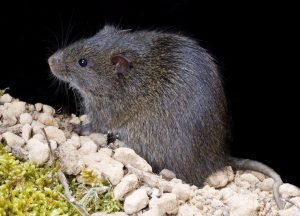Tanya Loos
These La Nińa years have allowed for abundant plant growth and much of our wildlife is thriving. This is a welcome reprieve after the long sad years of the Millenium Drought – and the weird mini droughts we experienced after that.
The adorable creature pictured here is a native Swamp Rat. By all reports they are doing very well in our region. Their extensive freshly dug tunnel networks are in my garden, my neighbour’s garden, my sister’s in Hepburn and a garden at Sailors falls. And I bet maybe in your garden too!
The tunnels are actually runways – half excavated tunnels through long grass and vegetation – that enable the rodents to run from burrow to burrow in relative safety. No other rat species makes these tunnel networks so if you have these runways, you very likely have Swamp Rats.
Swamp rats are found in moist dense vegetation and in Victoria they are commonly found along the coastal swamp areas. I first came across a road-killed Swamp Rat several years ago on Richardsons Lane, Porcupine Ridge. This lane courses through the headwaters of Middleton Creek.
Looking at its body so closely I could see its distinctive identifying features: short and rounded ears, and a tail that is less than the length of its body – both of which indicate it was a native rat. Our introduced Black Rats have longer narrower ears, and a long naked tail that is much longer than the body. Finally, the dark brown feet were a giveaway why the animal was a swamp rat and not a Bush Rat – Bush Rats have lighter coloured skin on their paws.

Swamp Rat. Grampians National Park.
Swamp Rats are closely related to Bush Rats, and even to our introduced rats. Many folks are surprised we have native rodents in Australia. In fact we have a wonderful and diverse rodent family. There are 13 genera found all over the country, occupying diverse habitats such as freshwater swamps, rainforests, grasslands, woodlands, forests, deserts and alpine regions. There is even a crab-eating specialist that lives by the sea known as the Water Mouse.
Many of our native species evolved 6-8 million years ago after crossing the New Guinea land bridge. The genera include Hopping Mice, Stick Nest Rats, Rock Rats, Tree Rats, and Water Rats.
Bush Rats, Swamp Rats and our introduced rats are all from the genus Rattus . They are more recent arrivals and are less specialized with fewer morphological adaptations than all the amazing rats and mice that have been here for millions of years.
Swamp Rats are mainly vegetarian, and may be partial to your home grown vegetables. Their enthusiastic tunnelling can upend delicate flowering plants as well. The best ways to discourage swamp rats from your garden beds are 1) wire mesh buried to a depth of 200 mm around your vegie patch and 2) keep vegetation surrounding your vegie patch low – if they do not have cover they will not build their runways. Perhaps try #2 first! This seems a lot less hassle than digging wire mesh around garden. Let me know how you go!
We don’t have any vegetables growing here, so I am delighted to see their tunnels and catch glimpses of them – once cruising by the aviary, and a second time sitting under a shrub munching on some plant matter. They have such endearing faces.
Tanya Loos is a local naturalist, author and environmental consultant who loves to work in the environmental not-for-profit sector. She is the author of “Daylesford Nature Diary” available from her website or from Paradise Books in Vincent Street, Daylesford.
Have you got any nature questions for Tanya? Send them in!














